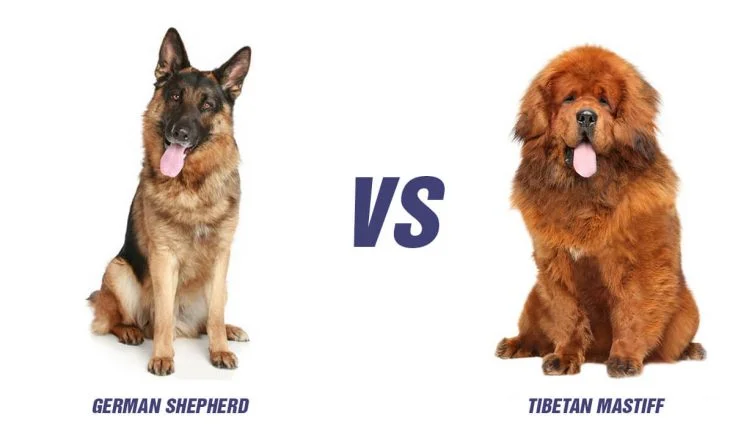The Tibetan Mastiff is a large, heavily-muscled, black-coated dog with a unique head and muzzle. It is an ancient breed that has been used as a guardian of the home, herder of livestock, and protector of the flock since the time of the Tibetan nomads. They are very powerful, energetic, and loyal dogs that thrive in cold environments.
German Shepherds are a domesticated breed of dog, originally bred for herding livestock, but now commonly kept as pets. They are one of the world’s most widely kept working breeds. German Shepherds are large, strong, and well-balanced. They have a history of being used as military and police dogs, messenger dogs, and search and rescue dogs.
While the Tibetan Mastiff and the German Shepherd are both strong and perfect guard dogs, these two breeds can vary quite drastically. It is important to learn the differences between them before making a decision on which dog would be best for your lifestyle.
Below are 10 main differences between Tibetan Mastiffs and German Shepherds.
1. Tibetan Mastiff Vs German Shepherd: Their History
| Tibetan Mastiff History | German Shepherd History |
| Tibetan Mastiff originated in Tibet. It is one of the oldest breeds of dog in existence and has been domesticated for over 3,000 years. | The German Shepherd Dog originated in 1899 in Germany as a working dog to herd sheep. |
2. Tibetan Mastiffs Are Bigger Than German Shepherds:
| Tibetan Mastiff Height/Weight | German Shepherd Height/Weight |
| The height of Tibetan Mastiffs ranges from 27 to 34 inches and their weight can range from 100 to 130 pounds. | The height of German Shepherds ranges from 22-26 inches while their weight can range from 42-90 pounds. |
3. German Shepherds Have Thicker Undercoats Than Tibetan Mastiffs:
| Tibetan Mastiff Coat | German Shepherd Coat |
| The Tibetan Mastiff’s long, coarse outer coat and a softer undercoat.
They come in many different colors and patterns like black-brown-tan, gray-black-brown, gray-brown-black, and so on. |
German Shepherd’s outer coat is thick and wavy, and the undercoat is thick and medium-length.
The coat comes in a variety of colors and patterns, including black, black and cream, black and silver, and white |
4. Tibetan Mastiffs Are More Suitable As Family Pets Than German Shepherd:
| Tibetan Mastiff Temperament | German Shepherd Temperament |
| Tibetan Mastiffs were bred to be canine companions. They are loyal, protective, and very gentle. They are also known to be intelligent and obedient. | German shepherds were originally bred for herding. These dogs are known to be dominant and may need a lot of socialization training to be fit for families with children. |
5. German Shepherds Are Far More Active Than Tibetan Mastiffs:
| Tibetan Mastiff Energy | German Shepherd Energy |
| Tibetan mastiffs are docile and calm by nature. | German Shepherds are extremely playful and energetic dogs that also need a lot of room to run and play. |
6. German Shepherds Are Easier to Train Than Tibetan Mastiffs:
| Tibetan Mastiff Trainability | German Shepherd Trainability |
| The Tibetan Mastiff is more difficult to train than the German Shepherd because of their stubbornness. | German shepherds are highly trainable, and they will learn commands quickly. This is because the shepherd’s ancestors were bred to be very obedient and responsive to their owner’s commands. |
7. Tibetan Mastiffs Need Less Exercise Than German Shepherds:
| Tibetan Mastiff Exercise Needs | German Shepherd Exercise Needs |
| Tibetan Mastiffs don’t need a lot of exercises. They only require around one hour of daily exercise per day to stay healthy and happy. | A German Shepherd needs at least two hours of exercise a day. They need to be walked on a regular basis, and will also need to be exercised with games and other activities. |
8. Grooming Is Easier With Tibetan Mastiffs:
| Tibetan Mastiff Grooming | German Shepherd Grooming |
| The Tibetan Mastiff’s grooming needs are minimal. They don’t need to be brushed or bathed often but should be brushed at least every two weeks. | The German Shepherd needs a lot of care in order to be healthy and clean. They need to be brushed every day to prevent mats and tangles. |
9. Tibetan Mastiffs Have A Longer Lifespan Than German Shepherds:
| Tibetan Mastiff Lifespan | German Shepherd Lifespan |
| The Tibetan Mastiff has an average lifespan of 12-14 years. | The average lifespan of a German Shepherd is 10-12 years. |
10. Tibetan Mastiffs Are More Expensive Than German Shepherds:
| Tibetan Mastiff Price | German Shepherd Price |
| Tibetan Mastiffs are likely to cost between $2,000-$6,000. | German Shepherds can cost between $800-$1,500. |
Similarities Between The Tibetan Mastiff And The German Shepherd
There are many similarities between the Tibetan Mastiff and the German Shepherd. They both are large, powerful dogs that are known for their strength. They both have muscular bodies, big heads, and strong jaws that can hold down large prey animals.
Both Tibetan Mastiff and German Shepherd are very intelligent dogs that are often used as guard dogs. They will bark at strangers or perceived threats to protect their owners or territory from any threats that would otherwise put them in danger.
Unfortunately, both German Shepherds and Tibetan Mastiffs do not have a good reputation as apartment dogs.
Conclusion
If you are looking for a new furry family member, both Tibetan Mastiff and German Shepherd may be of interest. But you should know that adopting either one of these two beautiful breeds is a lifetime commitment. You’ll need to make sure you understand more about both breeds to know if you can offer them a suitable home.
Here are some other articles that we have on the Tibetan Mastiff and the German Shepherd!
Which is the breed of your choice? The Tibetan Mastiff or the German Shepherd? Let us know in the comments below!
